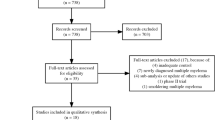Abstract
The aim of the study was to perform a meta-analysis of the efficacy and safety of (bortezomib plus lenalidomide/thalidomide)- vs (bortezomib or lenalidomide/thalidomide)-containing regimens as induction therapy in newly diagnosed multiple myeloma. We searched electronic and printed sources for relevant articles published. Inclusion criteria was as follows: randomized controlled trials (RCT) of (bortezomib plus lenalidomide/thalidomide) vs (bortezomib or lenalidomide/thalidomide)-containing regimens as induction therapy in newly diagnosed multiple myeloma. Two reviewers independently assessed potentially eligible studies and extracted relevant data. We retrieved five RCT studies including a total of 1,200 patients. Using the random-effects model to pool the five RCT with a statistically significant heterogeneity (P = 0.03; X 2 = 10.69; df = 4; I 2 = 63 %), the weighted risk ratios of a complete response (CR) for (bortezomib plus lenalidomide/thalidomide)-containing regimens was 1.81 (P = 0.005; 95 % CI: 1.20–2.73). When we excluded the study by Cavo et al. (Lancet 376:2075–2085, 2010), the pooled risk ratio for CR was 1.59 (P < 0.0001, 95 %CI: 1.29–1.96) with no statistically significant heterogeneity (P = 0.54; X 2 = 2.14; df = 3; I 2 = 0 %) among four RCT under the fixed effects mode. The pooled odds ratio for the main grade III/IV adverse events (the peripheral neuropathy, thrombotic events, and infections) were 1.76 (P = 0.32; 95 % CI: 0.58–5.31), 0.92 (P = 0.76, 95 %CI: 0.52–1.61), and 1.05 (P = 0.82, 95 % CI: 0.70–1.57), respectively. Our analysis showed (bortezomib plus lenalidomide/thalidomide)-containing regimens as induction treatment in newly diagnosed multiple myeloma improved CR but did not increase the risk of major adverse events (the peripheral neuropathy, thrombotic events, and infections).






Similar content being viewed by others
References
Laubach JP, Schlossman RL, Mitsiades CS, Anderson KC, Richardson PG (2011) Thalidomide, lenalidomide and bortezomib in the management of newly diagnosed multiple myeloma. Expert Rev Hematol 4(1):51–60
Kumar SK, Rajkumar SV, Dispenzieri A, Lacy MQ, Hayman SR, Buadi FK et al (2008) Improved survival in multiple myeloma and the impact of novel therapies. Blood 111(5):2516–2520
Mitsiades N, Mitsiades CS, Poulaki V, Chauhan D, Richardson PG, Hideshima T et al (2002) Apoptotic signaling induced by immunomodulatory thalidomide analogs in human multiple myeloma cells: therapeutic implications. Blood 99(12):4525–4530
Mitsiades N, Mitsiades CS, Richardson PG, Poulaki V, Tai YT, Chauhan D et al (2003) The proteasome inhibitor PS-341 potentiates sensitivity of multiple myeloma cells to conventional chemotherapeutic agents: therapeutic applications. Blood 101(6):2377–2380
Chanan-Khan AA, Giralt S (2010) Importance of achieving a complete response in multiple myeloma, and the impact of novel agents. J Clin Oncol 28(15):2612–2624
Dingli D, Pacheco JM, Nowakowski GS, Kumar SK, Dispenzieri A, Hayman SR et al (2007) Relationship between depth of response and outcome in multiple myeloma. J Clin Oncol 25(31):4933–4937
Durie BG, Harousseau JL, Miguel JS, Bladé J, Barlogie B, Anderson K et al (2006) International uniform response criteria for multiple myeloma. Leukemia 20(9):1467–1473
National Cancer Institute: Common terminology criteria for adverse events, v3.0. http://ctep.cancer.gov/protocolDevelopment/electronic_applications/ctc.htm#ctc_v3.0
Altman DG, Schulz KF, Moher D, Egger M, Davidoff F, Elbourne D et al (2001) The revised CONSORT statement for reporting randomized trials: explanation and elaboration. Ann Intern Med 134(8):663–694
Juni P, Altman DG, Egger M (2001) Systematic reviews in health care: assessing the quality of controlled clinical trials. BMJ 323:42–46
Cavo M, Tacchetti P, Patriarca F, Petrucci MT, Pantani L, Galli M et al (2010) Bortezomib with thalidomide plus dexamethasone compared with thalidomide plus dexamethasone as induction therapy before, and consolidation therapy after, double autologous stem-cell transplantation in newly diagnosed multiple myeloma: a randomised phase 3 study. Lancet 376(9758):2075–2085
Kumar S, Flinn I, Richardson PG, Hari P, Callander N, Noga SJ et al (2012) Randomized, multicenter, phase 2 study (EVOLUTION) of combinations of bortezomib, dexamethasone, cyclophosphamide, and lenalidomide in previously untreated multiple myeloma. Blood. doi:10.1182/blood-2011-11-395749
Moreau P, Avet-Loiseau H, Facon T, Attal M, Tiab M, Hulin C et al (2011) Bortezomib plus dexamethasone versus reduced-dose bortezomib, thalidomide plus dexamethasone as induction treatment before autologous stem cell transplantation in newly diagnosed multiple myeloma. Blood 118(22):5752–5758
Palumbo A, Bringhen S, Rossi D, Cavalli M, Larocca A, Ria R et al (2010) Bortezomib-melphalan-prednisone-thalidomide followed by maintenance with bortezomib-thalidomide compared with bortezomib-melphalan-prednisone for initial treatment of multiple myeloma: a randomized controlled trial. J Clin Oncol 28(34):5101–5109
Rosinol L, Cibeira MT, Martinez J, Mateos MV, Oriol A, Terol MJ et al (2009) Thalidomide/Dexamethasone (TD) vs Velcade/Thalidomide/Dexamethasone (VTD) vs. VBMCP/VBAD/Velcade as induction regimens prior to autologous stem cell transplantation (ASCT): results of a prospective phase III PETHEMA/GEM trial. ASH Ann Meet Abstr 114:130
Conflict of interest
The authors state that they have no conflict of interest.
Author information
Authors and Affiliations
Corresponding author
Rights and permissions
About this article
Cite this article
Wang, A., Duan, Q., Liu, X. et al. (Bortezomib plus lenalidomide/thalidomide)- vs (bortezomib or lenalidomide/thalidomide)-containing regimens as induction therapy in newly diagnosed multiple myeloma: a meta-analysis of randomized controlled trials. Ann Hematol 91, 1779–1784 (2012). https://doi.org/10.1007/s00277-012-1520-4
Received:
Accepted:
Published:
Issue Date:
DOI: https://doi.org/10.1007/s00277-012-1520-4




